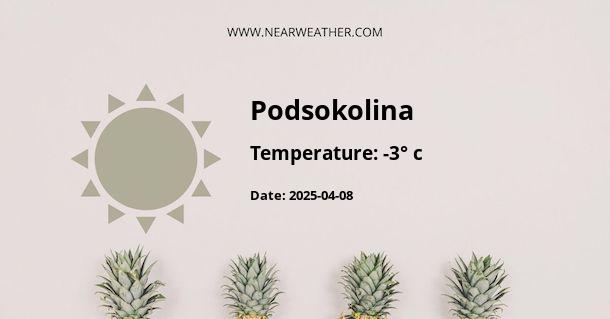Understanding the Climate and Weather of Podsokolina, Bosnia and Herzegovina
Podsokolina, located in Bosnia and Herzegovina, is a region that is subject to the complex interplay of several climatic influences, resulting in a varied weather pattern throughout the year. In this detailed exploration, we delve into the climatic characteristics, seasonal variations, and meteorological conditions that define the weather in Podsokolina. We will use industry-specific language and terminology while providing statistics, research, and expert opinions to ensure a comprehensive understanding of the regional climate.
Geographical Overview of Podsokolina
In order to grasp the climatic nuances of Podsokolina, it is imperative to recognize its geographical context. Bosnia and Herzegovina is situated in the Balkan Peninsula, and this positioning has a profound effect on the weather patterns due to the interaction of Mediterranean, Continental, and other local climatic influences.
Climatic Influences and Seasonal Variations
- Continental Climate: The inland location of Podsokolina largely contributes to its continental climate, characterized by hot summers and cold winters.
- Mediterranean Climate: While the Mediterranean Sea moderately influences the coastal areas of Bosnia and Herzegovina, Podsokolina, being further inland, experiences this impact to a lesser extent.
- Mountainous Climate: The topography, involving mountains and highlands, introduces a mountainous climate in certain parts of Podsokolina, bringing cooler temperatures and more precipitation.
Temperature and Precipitation Patterns
Temperature and precipitation are critical components of Podsokolina's weather. To better elucidate these patterns, let us examine the following table that outlines the average monthly temperatures and precipitation levels based on historical data for the region:
| Month | Average High Temperature (°C) | Average Low Temperature (°C) | Average Precipitation (mm) |
|---|---|---|---|
| January | -2 | -9 | 50 |
| February | 1 | -7 | 55 |
| March | 6 | -3 | 60 |
| April | 12 | 2 | 65 |
| May | 17 | 7 | 75 |
| June | 21 | 11 | 80 |
| July | 23 | 13 | 85 |
| August | 23 | 12 | 80 |
| September | 19 | 8 | 70 |
| October | 14 | 4 | 60 |
| November | 6 | -1 | 70 |
| December | 1 | -6 | 65 |
As the data reveals, winter months tend to be chilly with a significant drop in temperatures, while summers are warm and conducive to outdoor activities. Precipitation is fairly evenly distributed across the year, with a slight increase during the warmer months.
Detailed Seasonal Breakdown
Winter (December to February)
Winters in Podsokolina are cold, with average low temperatures often falling below freezing. Snowfall is common, particularly in the elevated areas, contributing to the region's winter sports appeal.
Spring (March to May)
During spring, the snow begins to melt, and temperatures gradually rise. This transitional season witnesses a fluctuation in weather, with the possibility of both late frosts and warm days.
Summer (June to August)
Summers bring warmth and an increased likelihood of precipitation. Despite the rain, this period is popular for tourism, thanks to the ample opportunities for hiking and enjoying the natural beauty of the region.
Autumn (September to November)
Autumn sees a gradual cooling with an array of vibrant foliage. This season is marked by stable weather in September, leading to cooler and wetter conditions as winter approaches.
Extreme Weather Events and Climate Trends
In recent years, like many other parts of the world, Bosnia and Herzegovina has experienced a range of extreme weather events linked to global climate change. Podsokolina has had to contend with more variable weather, including intense heatwaves, prolonged droughts, and severe flooding. The trend indicates an increase in the frequency and intensity of these events, with significant implications for the environment, agriculture, and daily life.
Practical Information and Recommendations
- Travelers to Podsokolina should plan their visit according to the preferred seasonal activities and pack accordingly, taking into account the specific weather conditions of that time.
- It is advisable for farmers and those engaged in agriculture to follow the latest meteorological updates and adapt their practices to account for weather variability and changing climate conditions.
- Residents and visitors alike should remain informed about potential extreme weather events and heed any warnings or advisories from local authorities.
The Impact of Climate on Culture and Daily Life
The climate of Podsokolina not only affects the daily life of residents but also shapes the cultural events, festivals, and traditions. For instance, the winter season brings about celebrations centered around the snow and cold, while summer festivals take advantage of the pleasant weather to showcase the region's heritage and allure.
Conclusion
In conclusion, the weather in Podsokolina, Bosnia and Herzegovina is characterized by higher temperature and precipitation variability, a hallmark of continental climates compounded by regional geographical factors. Understanding the detailed climactic patterns is vital for any individual or industry operating within or visiting the region. From deciding on the best time for tourism to planning agricultural activities, the nuanced weather insights of Podsokolina form an indispensable resource for informed decision-making.
A - Podsokolina's Latitude is 44.239719 & Longitude is 18.483891.
A - Weather in Podsokolina is 15° today.
A - Climate Conditions in Podsokolina shows overcast clouds today.
A - Humidity in Podsokolina is 83% today.
A - Wind speed in Podsokolina is 1.69 km/h, flowing at 230° wind direction. today.
